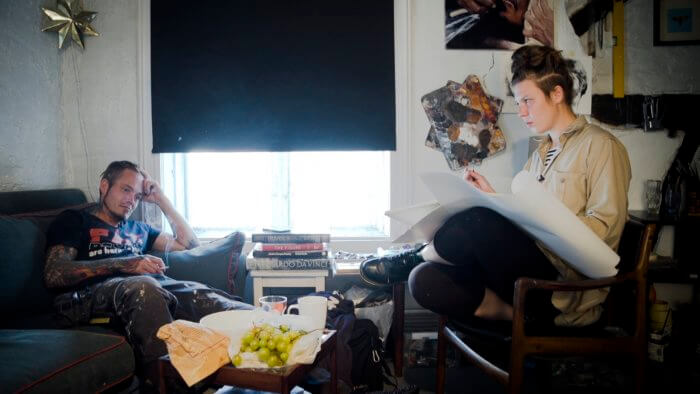“The Painter and the Thief” almost feels too neat to be a real documentary. It starts off with a high-concept premise: Czech artist Barbora Kysilkova met Karl-Bertil Nordland, a thief who stole her paintings from an Oslo gallery, and while he was still awaiting trial she asked him to pose for her drawings. Their relationship went through many changes from there. While the exact chronology of “The Painter and the Thief” is hazy, director Benjamin Ree had access to many intimate moments of Nordland’s life. Ree films him buying heroin (although hands block the camera so that no one is legally implicated), in jail and in the hospital, and breaking down in tears the first time he sees Kysilkova’s painting of him.
Ree lays out his documentary’s narrative better than most fiction films. “The Painter and the Thief” starts out looking like a Norwegian equivalent to Hollywood movies like “Dangerous Minds,” in which white teachers condescendingly improve the lives of their underclass students. Kysilkova meets Nordland when he’s at his most desperate. Explaining how he got to the point where he stole her paintings, he explains that he had stayed up for four days on a 100-pill amphetamine binge while also using heroin. He still seems dazed, weak, and dead-eyed, although more functional. Before she meets Nordland, her boyfriend looks at a photo of Nordland’s chest and reads out his “snitches are a dying breed” tattoo.
But if the first 20 minutes of “The Painter and the Thief” privilege Kysilkova’s perspective, letting her deliver a voice-over that comments on Nordland’s life, it hands the reigns over to Nordland. In turn, he gets the voice-over, getting a chance to speak about his childhood. While he tells Kysilkova a story about parents divorcing when he was eight, addiction, and gang life, his autobiography also has nuance. He emphasizes that he was also a sober student and that he works at carpentry.
That brings us to another point. The film’s Christian symbolism is hardly accidental. Beyond being a carpenter, Norland, in a car accident that nearly kills him, gets a wound on his wrist that turns into a permanent scar resembling stigmata. He himself recognizes the similarity. Kysilkova later paints the two of them posed in a pieta.

The differences between Norwegian and American Christianity, however, can be seen in the two societies’ prison systems. Norway does more than pay mere lip service to redemption and forgiveness. Nordland served 75 days for the art theft, but the crimes that led to the later car accident were more serious. In voice-over of a montage of Nordland looking pensive in different settings, a judge reads out his sentence for those crimes. Yet, as far as Nordland falls, he is able to pick up his life again, and his hospitalization actually seems more oppressive than his time in jail. (For a month after the car accident, he was confined to a wheelchair, and doctors didn’t know if he would be able to walk again.)
At first, Kysilkova seems a relatively well-off woman taking advantage of a desperate man. Her boyfriend brings this possibility up, suggesting she’s exploiting and aestheticizing Nordland’s suffering for the benefit of her art. She angrily dismisses the suggestion but admits she’s given that real thought. We learn that the painter had to flee Berlin for Norway to escape a long-term violent relationship. She’s also not particularly successful in the art world or financially stable. In a phone call, she admits to owing three months’ rent.
The level of access that Ree got is truly surprising. The questions that Kysilkova gets asked about exploitation could also be directed toward him. Nordland seems shockingly un-self-conscious that a cameraman is around to capture him breaking down in tears. Ree does create distance from his subjects by layering sound over scenes with unrelated images.
One wonders if the reality of these people’s lives could really be captured so neatly into a story with twists and turns. But “The Painter and the Thief” takes an idea that’s initially intriguing and goes beyond it, spinning out something truly impressive.
THE PAINTER AND THE THIEF | Directed by Benjamin Ree | Neon | In English and Norwegian with English subtitles | Starts streaming May 22 | neonrated.com
To sign up for the Gay City News email newsletter, visit gaycitynews.com/newsletter.



































